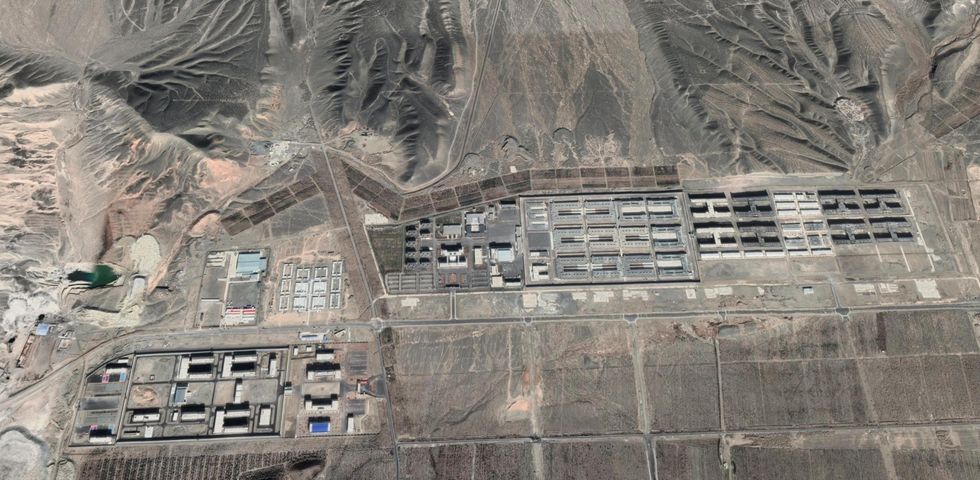Satellite Imagery for Everyone
Here’s how you can order up a high-resolution image of any place on Earth
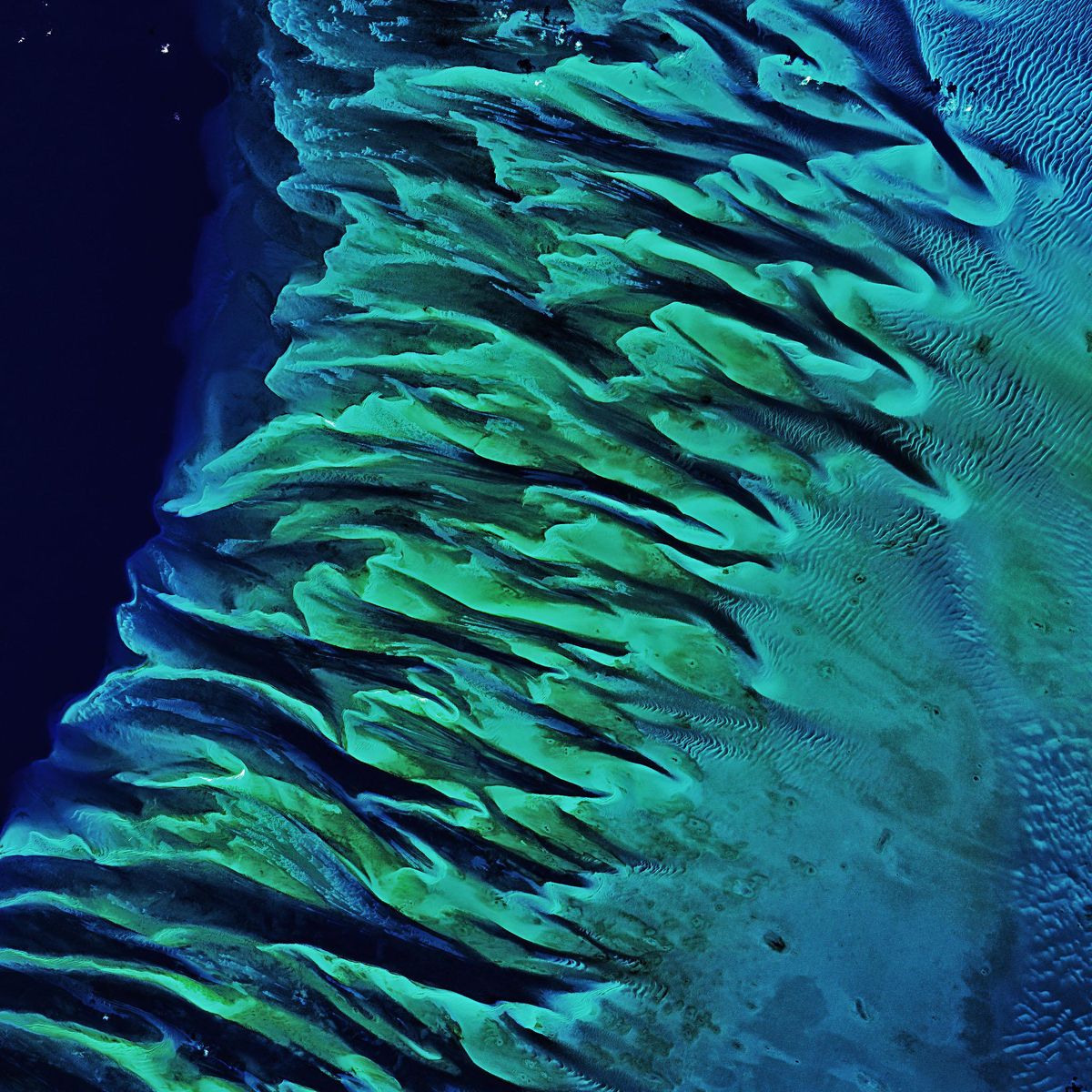
Every day, satellites circling overhead capture trillions of pixels of high-resolution imagery of the surface below. In the past, this kind of information was mostly reserved for specialists in government or the military. But these days, almost anyone can use it.
That’s because the cost of sending payloads, including imaging satellites, into orbit has dropped drastically. High-resolution satellite images, which used to cost tens of thousands of dollars, now can be had for the price of a cup of coffee.
What’s more, with the recent advances in artificial intelligence, companies can more easily extract the information they need from huge digital data sets, including ones composed of satellite images. Using such images to make business decisions on the fly might seem like science fiction, but it is already happening within some industries.
These underwater sand dunes adorn the seafloor between Andros Island and the Exuma islands in the Bahamas. The turquoise to the right reflects a shallow carbonate bank, while the dark blue to the left marks the edge of a local deep called Tongue of the Ocean. This image was captured in April 2020 using the Moderate Resolution Imaging Spectroradiometer on NASA’s Terra satellite.
Joshua Stevens/NASA Earth Observatory
Here’s a brief overview of how you, too, can access this kind of information and use it to your advantage. But before you’ll be able to do that effectively, you need to learn a little about how modern satellite imagery works.
The orbits of Earth-observation satellites generally fall into one of two categories: GEO and LEO. The former is shorthand for geosynchronous equatorial orbit. GEO satellites are positioned roughly 36,000 kilometers above the equator, where they circle in sync with Earth’s rotation. Viewed from the ground, these satellites appear to be stationary, in the sense that their bearing and elevation remain constant. That’s why GEO is said to be a geostationary orbit.
Such orbits are, of course, great for communications relays—it’s what allows people to mount satellite-TV dishes on their houses in a fixed orientation. But GEO satellites are also appropriate when you want to monitor some region of Earth by capturing images over time. Because the satellites are so high up, the resolution of that imagery is quite coarse, however. So these orbits are primarily used for observation satellites designed to track changing weather conditions over broad areas.
Being stationary with respect to Earth means that GEO satellites are always within range of a downlink station, so they can send data back to Earth in minutes. This allows them to alert people to changes in weather patterns almost in real time. Most of this kind of data is made available for free by the U.S. National Oceanographic and Atmospheric Administration.
In March 2021, the container ship Ever Given ran aground, blocking the Suez Canal for six days. This satellite image of the scene, obtained using synthetic-aperture radar, shows the kind resolution that is possible with this technology.
Capella Space
The other option is LEO, which stands for low Earth orbit. Satellites placed in LEO are much closer to the ground, which allows them to obtain higher-resolution images. And the lower you can go, the better the resolution you can get. The company Planet, for example, increased the resolution of its recently completed satellite constellation, SkySat, from 72 centimeters per pixel to just 50 cm—an incredible feat—by lowering the orbits its satellites follow from 500 to 450 km and improving the image processing.
The best commercially available spatial resolution for optical imagery is 25 cm, which means that one pixel represents a 25-by-25-cm area on the ground—roughly the size of your laptop. A handful of companies capture data with 25-cm to 1-meter resolution, which is considered high to very high resolution in this industry. Some of these companies also offer data from 1- to 5-meter resolution, considered medium to high resolution. Finally, several government programs have made optical data available at 10-, 15-, 30-, and 250-meter resolutions for free with open data programs. These include NASA/U.S. Geological Survey Landsat, NASA MODIS (Moderate Resolution Imaging Spectroradiometer), and ESA Copernicus. This imagery is considered low resolution.
Because the satellites that provide the highest-resolution images are in the lowest orbits, they sense less area at once. To cover the entire planet, a satellite can be placed in a polar orbit, which takes it from pole to pole. As it travels, Earth rotates under it, so on its next pass, it will be above a different part of Earth.
Many of these satellites don’t pass directly over the poles, though. Instead, they are placed in a near-polar orbit that has been specially designed to take advantage of a subtle bit of physics. You see, the spinning Earth bulges outward slightly at the equator. That extra mass causes the orbits of satellites that are not in polar orbits to shift or (technically speaking) to precess. Satellite operators often take advantage of this phenomenon to put a satellite in what’s called a sun-synchronous orbit. Such orbits allow the repeated passes of the satellite over a given spot to take place at the same time of day. Not having the pattern of shadows shift between passes helps the people using these images to detect changes.
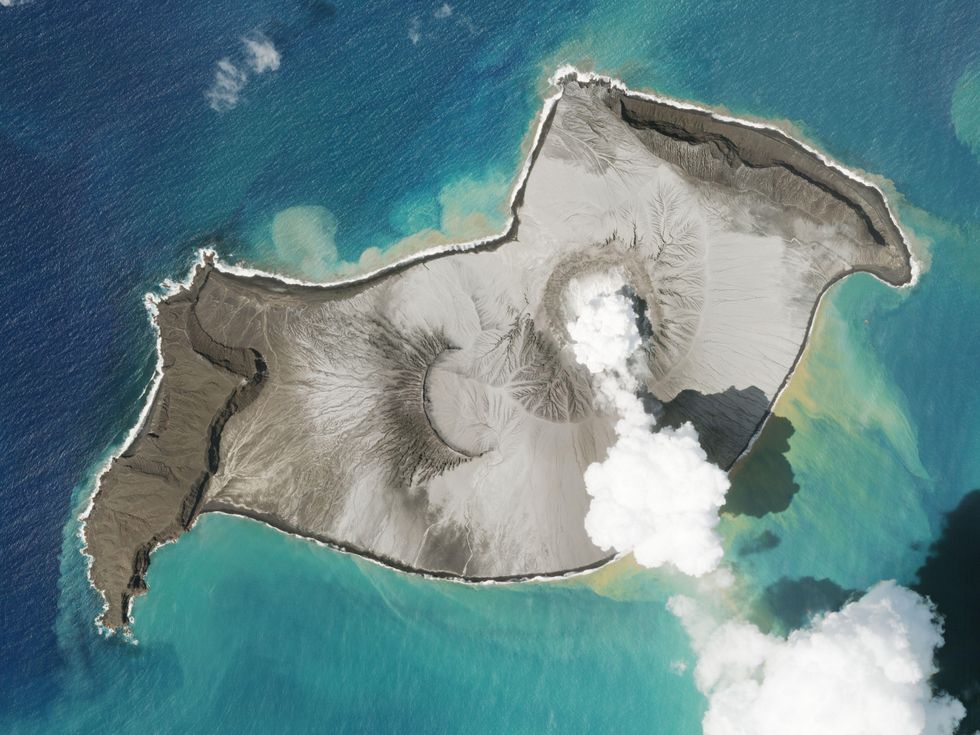
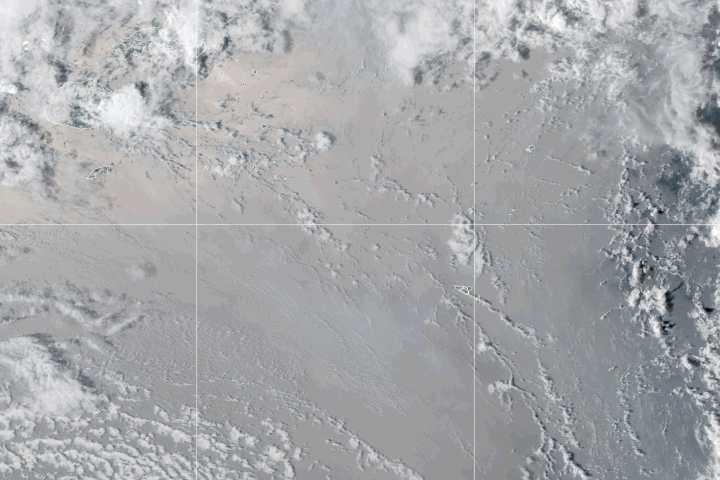
On 15 January of this year, an immensely powerful volcanic eruption rocked an uninhabited island in the South Pacific known as Hunga Tonga-Hunga Ha’apai [top]. The massive eruption, which had far-reaching effects, was captured by NOAA's Geostationary Operational Environmental Satellite 17 [bottom].
Top: SkySat/Planet; Bottom: Joshua Stevens and Lauren Dauphin/NOAA/NESDIS/NASA
It usually takes 24 hours for a satellite in polar orbit to survey the entire surface of Earth. To image the whole world more frequently, satellite companies use multiple satellites, all equipped with the same sensor and following different orbits. In this way, these companies can provide more frequently updated images of a given location. For example, Maxar’s Worldview Legion constellation, launching later this year, includes six satellites.
After a satellite captures some number of images, all that data needs to be sent down to Earth and processed. The time required for that varies.
DigitalGlobe (which Maxar acquired in 2017) recently announced that it had managed to send data from a satellite down to a ground station and then store it in the cloud in less than a minute. That was possible because the image sent back was of the parking lot of the ground station, so the satellite didn’t have to travel between the collection point and where it had to be to do the data “dumping,” as this process is called.
In general, Earth-observation satellites in LEO don’t capture imagery all the time—they do that only when they are above an area of special interest. That’s because these satellites are limited to how much data they can send at one time. Typically, they can transmit data for only 10 minutes or so before they get out of range of a ground station. And they cannot record more data than they’ll have time to dump.
Currently, ground stations are located mostly near the poles, the most visited areas in polar orbits. But we can soon expect distances to the nearest ground station to shorten because both Amazon and Microsoft have announced intentions to build large networks of ground stations located all over the world. As it turns out, hosting the terabytes of satellite data that are collected daily is big business for these companies, which sell their cloud services (Amazon Web Services and Microsoft’s Azure) to satellite operators.
For now, if you are looking for imagery of an area far from a ground station, expect a significant delay—maybe hours—between capture and transmission of the data. The data will then have to be processed, which adds yet more time. The fastest providers currently make their data available within 48 hours of capture, but not all can manage that. While it is possible, under ideal weather conditions, for a commercial entity to request a new capture and get the data it needs delivered the same week, such quick turnaround times are still considered cutting edge.
The best commercially available spatial resolution is 25 centimeters for optical imagery, which means that one pixel represents something roughly the size of your laptop.
I’ve been using the word “imagery,” but it’s important to note that satellites do not capture images the same way ordinary cameras do. The optical sensors in satellites are calibrated to measure reflectance over specific bands of the electromagnetic spectrum. This could mean they record how much red, green, and blue light is reflected from different parts of the ground. The satellite operator will then apply a variety of adjustments to correct colors, combine adjacent images, and account for parallax, forming what’s called a true-color composite image, which looks pretty much like what you would expect to get from a good camera floating high in the sky and pointed directly down.
Imaging satellites can also capture data outside of the visible-light spectrum. The near-infrared band is widely used in agriculture, for example, because these images help farmers gauge the health of their crops. This band can also be used to detect soil moisture and a variety of other ground features that would otherwise be hard to determine.
Longer-wavelength “thermal” IR does a good job of penetrating smoke and picking up heat sources, making it useful for wildfire monitoring. And synthetic-aperture radar satellites, which I discuss in greater detail below, are becoming more common because the images they produce aren’t affected by clouds and don’t require the sun for illumination.
You might wonder whether aerial imagery, say, from a drone, wouldn’t work at least as well as satellite data. Sometimes it can. But for many situations, using satellites is the better strategy. Satellites can capture imagery over areas that would be difficult to access otherwise because of their remoteness, for example. Or there could be other sorts of accessibility issues: The area of interest could be in a conflict zone, on private land, or in another place that planes or drones cannot overfly.
So with satellites, organizations can easily monitor the changes taking place at various far-flung locations. Satellite imagery allows pipeline operators, for instance, to quickly identify incursions into their right-of-way zones. The company can then take steps to prevent a disastrous incident, such as someone puncturing a gas pipeline while construction is taking place nearby.
This SkySat image shows the effect of a devastating landslide that took place on 30 December 2020. Debris from that landslide destroyed buildings and killed 10 people in the Norwegian village of Ask.
SkySat/Planet
The ability to compare archived imagery with recently acquired data has helped a variety of industries. For example, insurance companies sometimes use satellite data to detect fraudulent claims (“Looks like your house had a damaged roof when you bought it…”). And financial-investment firms use satellite imagery to evaluate such things as retailers’ future profits based on parking-lot fullness or to predict crop prices before farmers report their yields for the season.
Satellite imagery provides a particularly useful way to find or monitor the location of undisclosed features or activities. Sarah Parcak of the University of Alabama, for example, uses satellite imagery to locate archaeological sites of interest. 52Impact, a consulting company in the Netherlands, identified undisclosed waste dump sites by training an algorithm to recognize their telltale spectral signature. Satellite imagery has also helped identify illegal fishing activities, fight human trafficking, monitor oil spills, get accurate reporting on COVID-19 deaths, and even investigate Uyghur internment camps in China—all situations where the primary actors couldn’t be trusted to accurately report what’s going on.
Despite these many successes, investigative reporters and nongovernmental organizations aren’t yet using satellite data regularly, perhaps because even the small cost of the imagery is a deterrent. Thankfully, some kinds of low-resolution satellite data can be had for free.
The first place to look for free satellite imagery is the Copernicus Open Access Hub and EarthExplorer. Both offer free access to a wide range of open data. The imagery is lower resolution than what you can purchase, but if the limited resolution meets your needs, why spend money?
If you require medium- or high-resolution data, you might be able to buy it directly from the relevant satellite operator. This field recently went through a period of mergers and acquisitions, leaving only a handful of providers, the big three in the West being Maxar and Planet in the United States and Airbus in Germany. There are also a few large Asian providers, such as SI Imaging Services in South Korea and Twenty First Century Aerospace Technology in Singapore. Most providers have a commercial branch, but they primarily target government buyers. And they often require large minimum purchases, which is unhelpful to companies looking to monitor hundreds of locations or fewer.
Expect the distance to the nearest ground station to shorten because both Amazon and Microsoft have announced intentions to build large networks of ground stations located all over the world.
Fortunately, approaching a satellite operator isn’t the only option. In the past five years, a cottage industry of consultants and local resellers with exclusive deals to service a certain market has sprung up. Aggregators and resellers spend years negotiating contracts with multiple providers so they can offer customers access to data sets at more attractive prices, sometimes for as little as a few dollars per image. Some companies providing geographic information systems—including Esri, L3Harris, and Safe Software—have also negotiated reselling agreements with satellite-image providers.
Traditional resellers are middlemen who will connect you with a salesperson to discuss your needs, obtain quotes from providers on your behalf, and negotiate pricing and priority schedules for image capture and sometimes also for the processing of the data. This is the case for Apollo Mapping, European Space Imaging, Geocento, LandInfo, Satellite Imaging Corp., and many more. The more innovative resellers will give you access to digital platforms where you can check whether an image you need is available from a certain archive and then order it. Examples include LandViewer from EOS and Image Hunter from Apollo Mapping.
More recently, a new crop of aggregators began offering customers the ability to programmatically access Earth-observation data sets. These companies work best for people looking to integrate such data into their own applications or workflows. These include the company I work for, SkyWatch, which provides such a service, called EarthCache. Other examples are UP42 from Airbus and Sentinel Hub from Sinergise.
While you will still need to talk with a sales rep to activate your account—most often to verify you will use the data in ways that fits the company’s terms of service and licensing agreements—once you’ve been granted access to their applications, you will be able to programmatically order archive data from one or multiple providers. SkyWatch is, however, the only aggregator allowing users to programmatically request future data to be collected (“tasking a satellite”).
While satellite imagery is fantastically abundant and easy to access today, two changes are afoot that will expand further what you can do with satellite data: faster revisits and greater use of synthetic-aperture radar (SAR).
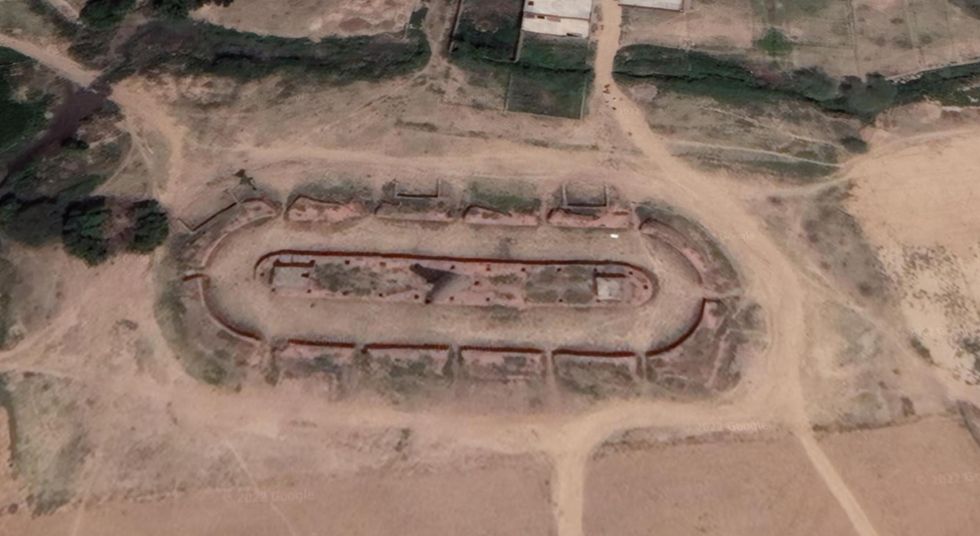
The first of these developments is not surprising. As more Earth-observation satellites are put into orbit, more images will be taken, more often. So how frequently a given area is imaged by a satellite will increase. Right now, that’s typically two or three times a week. Expect the revisit rate soon to become several times a day. This won’t entirely address the challenge of clouds obscuring what you want to view, but it will help.
The second development is more subtle. Data from the two satellites of the European Space Agency’s Sentinel-1 SAR mission, available at no cost, has enabled companies to dabble in SAR over the last few years.
With SAR, the satellite beams radio waves down and measures the return signals bouncing off the surface. It does that continually, and clever processing is used to turn that data into images. The use of radio allows these satellites to see through clouds and to collect measurements day and night. Depending on the radar band that’s employed, SAR imagery can be used to judge material properties, moisture content, precise movements, and elevation.
As more companies get familiar with such data sets, there will no doubt be a growing demand for satellite SAR imagery, which has been widely used by the military since the 1970s. But it’s just now starting to appear in commercial products. You can expect those offerings to grow dramatically, though.
Indeed, a large portion of the money being invested in this industry is currently going to fund large SAR constellations, including those of Capella Space, Iceye, Synspective, XpressSAR, and others. The market is going to get crowded fast, which is great news for customers. It means they will be able to obtain high-resolution SAR images of the place they’re interested in, taken every hour (or less), day or night, cloudy or clear.
People will no doubt figure out wonderful new ways to employ this information, so the more folks who have access to it, the better. This is something my colleagues at SkyWatch and I deeply believe, and it’s why we’ve made it our mission to help democratize access to satellite imagery.
One day in the not-so-distant future, Earth-observation satellite data might become as ubiquitous as GPS, another satellite technology first used only by the military. Imagine, for example, being able to take out your phone and say something like, “Show me this morning’s soil-moisture map for Grover’s Corners High; I want to see whether the baseball fields are still soggy.”
This article appears in the March 2022 print issue as “A Boom with a View.”
Editor’s note: The original version of this article incorrectly stated that Maxar’s Worldview Legion constellation launched last year.
- Satellites and AI Monitor Chinese Economy's Reaction to ... ›
- 9 Earth-Imaging Start-ups to Watch - IEEE Spectrum ›
- U.S. Eases Restrictions on Private Remote-Sensing Satellites - IEEE ... ›
- Commercial Satellites Are National Security’s Next Frontier - IEEE Spectrum ›
- Synthetic-Aperture Radar Tech Maps Disaster Relief’s Future - IEEE Spectrum ›
- Landsat Proved the Power of Remote Sensing - IEEE Spectrum ›
